For reptile enthusiasts looking to create a vertical paradise in their terrariums, climbing lizards offer fascinating behaviors and dynamic displays that can transform an ordinary enclosure into a living, moving ecosystem. These arboreal and semi-arboreal species have evolved specialized adaptations like toe pads, strong limbs, and prehensile tails that allow them to navigate vertical surfaces with impressive agility. Unlike ground-dwelling reptiles, these climbing specialists utilize the full three-dimensional space of their habitats, creating opportunities for more naturalistic enclosure designs that showcase their remarkable abilities. Whether you’re a beginner looking for your first reptilian companion or an experienced keeper seeking to diversify your collection, this guide explores 13 captivating lizard species that will have you looking up rather than down to spot your scaly friend.
13. Crested Gecko (Correlophus ciliatus)
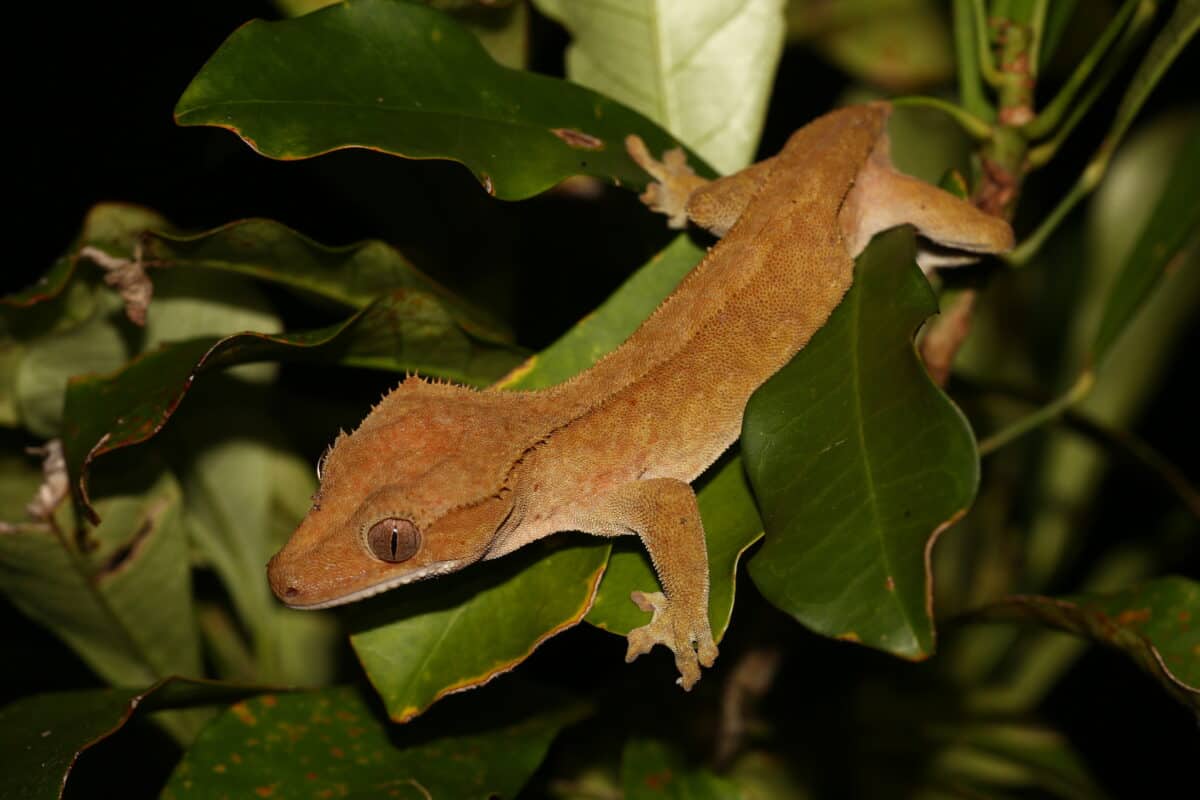
The crested gecko has become one of the most popular pet reptiles due to its docile nature, manageable size, and minimal care requirements. Native to New Caledonia, these nocturnal climbers possess specialized toe pads covered in microscopic hairs called setae that create molecular bonds with surfaces, allowing them to scale virtually any texture—even glass. Their distinctive crest of skin that runs from eye to eye gives them their name and adds to their charismatic appearance. Perhaps most appealingly for beginners, crested geckos don’t require UVB lighting or live insect feeding, as they thrive on commercially available fruit-based powder diets. Their prehensile tail, while not regenerative if lost, aids in climbing and balance as they navigate branches and plants in their enclosure.
12. Green Anole (Anolis carolinensis)

Often referred to as the American chameleon due to its ability to change color (though not related to true chameleons), the green anole is a native North American lizard that makes an excellent beginner pet for climbing enthusiasts. These slender lizards typically measure 5-8 inches in total length and can shift from bright green to brown based on temperature, mood, and environment. Their specialized toe pads allow them to climb virtually any surface, and they’ll utilize every vertical inch of their enclosure. Green anoles are diurnal and highly active, providing continuous entertainment as they patrol their territory, display their bright red dewlaps (throat fans), and hunt insects. While not as handleable as some larger species, their accessible price point and straightforward care requirements make them an ideal introduction to arboreal lizard keeping.
11. Tokay Gecko (Gekko gecko)
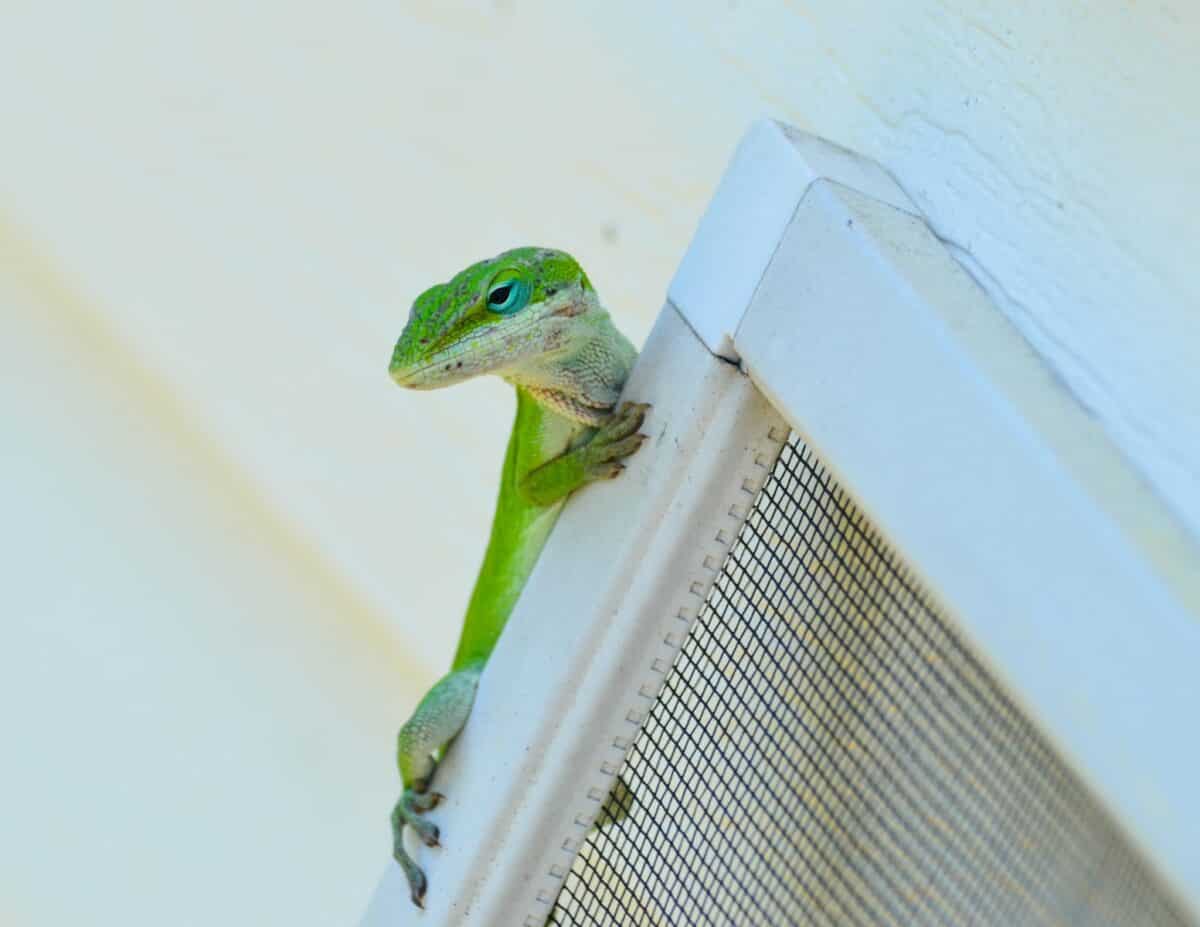
For keepers seeking a more challenging and visually striking climber, the tokay gecko offers vibrant coloration paired with a bold personality. These large geckos, reaching 10-15 inches in length, display stunning blue-gray bodies adorned with bright orange or red spots. Native to Southeast Asia, tokays possess extraordinary climbing abilities thanks to their specialized toe pads containing millions of microscopic hairs. However, potential owners should be aware of their defensive temperament—wild-caught specimens especially are known for their powerful bite and territorial vocalization (a loud “to-kay” call that gives them their name). While not recommended for beginners or those seeking a handleable pet, captive-bred tokays can become more tolerant with consistent, gentle interaction. Their dramatic appearance, vocal nature, and impressive climbing prowess make them fascinating display animals for experienced keepers willing to respect their space.
10. Chinese Water Dragon (Physignathus cocincinus)

The Chinese water dragon combines arboreal climbing skills with semi-aquatic tendencies, creating one of the most versatile and engaging lizard pets. These bright green lizards grow to impressive sizes (2-3 feet total length) and feature distinctive crests running from their heads down their backs and tails. Native to the tropical canopies of Southeast Asia, they’re excellent climbers that require tall enclosures with numerous branches and platforms at varying heights. What sets water dragons apart is their affinity for water—they’re strong swimmers who will dive from branches into water features when startled, mimicking their natural predator avoidance behavior. While juveniles can be skittish, captive-bred specimens typically grow into confident adults that may accept regular handling. Their intelligence, active daytime behavior, and striking appearance make them rewarding pets for intermediate keepers willing to invest in larger habitat setups.
9. Gargoyle Gecko (Rhacodactylus auriculatus)
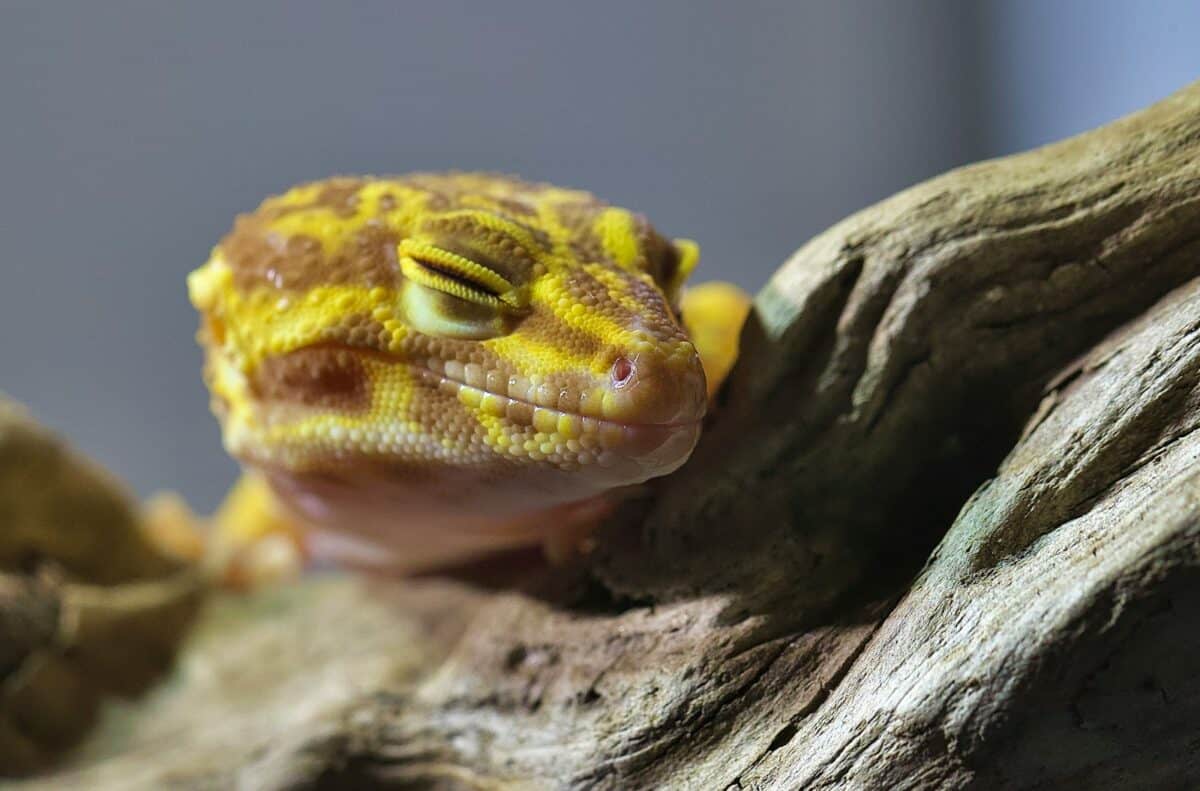
Closely related to the crested gecko, gargoyle geckos offer similar easy care requirements with a distinctively different aesthetic. Named for the bumpy, horn-like projections on their heads that resemble the stone creatures adorning gothic architecture, these New Caledonian geckos reach 7-9 inches in length. Their textured skin comes in various patterns and colors, from subtle earth tones to vibrant oranges and reds. Like their crested cousins, gargoyles possess impressive climbing abilities thanks to specialized toe pads and can be maintained on commercially prepared fruit diets supplemented with insects. They tend to be slightly more terrestrial than crested geckos but still utilize vertical space extensively, moving between ground level and elevated perches. Generally less skittish than cresties, many gargoyle geckos become reasonably tolerant of gentle handling, making them excellent pets for beginners seeking a low-maintenance climbing lizard with character.
8. Carolina Anole (Anolis carolinensis)

Often mistaken for chameleons due to their color-changing abilities, Carolina anoles are native to the southeastern United States and make charming, active climbing pets. These slender green lizards measure 5-8 inches in length and can shift from emerald green to brown based on temperature, stress levels, and social interactions. Their specialized toe pads contain microscopic structures that create molecular bonds with surfaces, allowing them to climb glass, plants, and virtually any texture in their environment. Carolina anoles are diurnal and highly territorial, with males frequently displaying their bright red dewlaps to establish dominance or attract females. While not typically handleable pets, their constant activity, low cost, and simple care requirements make them perfect for keepers who prefer observation over interaction. Provide plenty of vertical climbing surfaces, appropriate UVB lighting, and a diet of small insects, and these native lizards will thrive in captivity.
7. Day Gecko (Phelsuma spp.)
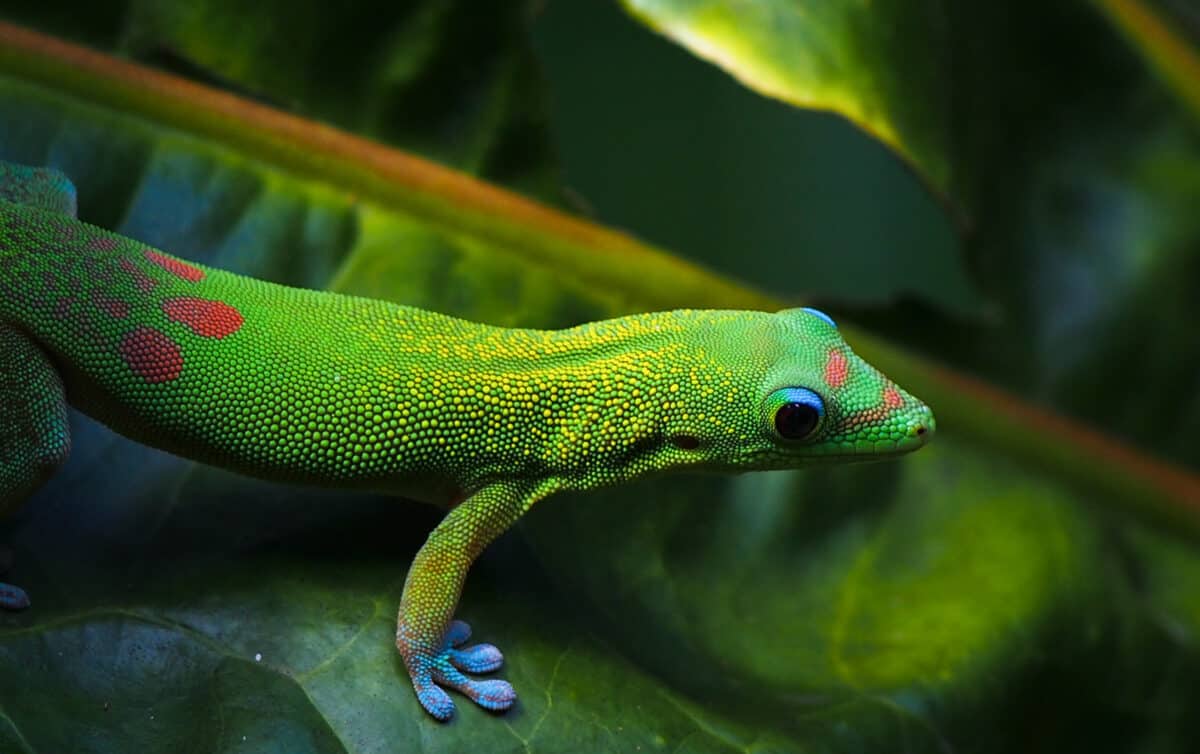
Day geckos comprise several species of stunningly colorful, diurnal climbers that bring vibrant tropical beauty to any collection. These Madagascar natives feature electric green bodies often accented with red, blue, or yellow markings that pop against the verdant background. Unlike many pet geckos, day geckos are strictly daytime creatures, making them more visible and active when owners are most likely to observe them. Their specialized toe pads allow for incredible climbing abilities, including scaling glass surfaces with ease. Species vary in size from the tiny 3-inch gold dust day gecko (Phelsuma laticauda) to the substantial 12-inch giant day gecko (Phelsuma grandis). While not suited for handling, their skin tears easily when grabbed—day geckos compensate with their jewel-like appearance and fascinating behaviors. They’re among the few geckos that consume nectar and fruit in the wild, requiring specialized diets that include commercially prepared fruit mixes supplemented with insects for optimal health in captivity.
6. Bearded Dragon (Pogona vitticeps)

While primarily known as terrestrial lizards, bearded dragons are surprisingly adept climbers that thoroughly enjoy scaling branches, rocks, and other elevated surfaces in their enclosures. These popular Australian reptiles grow to about 18-24 inches and possess strong limbs with sharp claws that allow them to navigate uneven surfaces with confidence. Unlike specialized climbers with toe pads, bearded dragons rely on physical strength and balance to reach elevated positions. In captivity, “beardies” frequently seek the highest points in their terrariums, often basking on elevated platforms directly under heat lamps. This climbing behavior mimics their natural tendency to seek elevated positions for thermoregulation and predator avoidance in the wild. Their docile temperament, handleability, and omnivorous diet make them excellent pets for beginners, while their climbing antics provide enrichment and entertainment. Providing sturdy branches, rock formations, and elevated platforms allows these semi-arboreal lizards to express their natural climbing behaviors while creating a more dynamic habitat.
5. Blue-Tongued Skink (Tiliqua spp.)

Although blue-tongued skinks are predominantly ground-dwelling reptiles, many species display surprising climbing abilities when given appropriate opportunities. These stocky, large-bodied lizards from Australia and Indonesia are known for their distinctive bright blue tongues, which they display when threatened. While lacking the specialized toe pads of true arboreal species, blue-tongues possess strong limbs and claws that allow them to navigate low branches, rocks, and gentle inclines in captivity. This climbing behavior is more pronounced in younger specimens, who may seek elevated positions for basking or exploration. Their docile nature, manageable size (18-24 inches), and omnivorous diet make them excellent pets for beginners, while their occasional climbing provides enrichment and exercise. While tall enclosures aren’t necessary, providing sturdy, low branches and elevated platforms creates environmental variety that encourages natural behaviors and exercise. Their semi-arboreal tendencies illustrate how even primarily terrestrial species can benefit from three-dimensional habitat design.
4. Cuban Knight Anole (Anolis equestris)

The Cuban knight anole stands as the giant among anole species, reaching impressive lengths of 13-20 inches and displaying a brilliant emerald green coloration that makes it an eye-catching terrarium centerpiece. Native to Cuba but established in parts of Florida, these powerful lizards are dedicated arboreal specialists with specialized toe pads allowing them to scale virtually any surface with ease. Their large size and territorial nature demand spacious, tall enclosures that accommodate their climbing lifestyle. Knight anoles are known for their dramatic color changes (shifting to brown or dark green when stressed), prominent dewlap displays, and bold personality. While not typically handleable due to their defensive biting and stress susceptibility, they compensate by being highly visible and active display animals. Their diet consists primarily of large insects, but they occasionally consume small vertebrates and fruit in the wild. For experienced keepers seeking a dramatic, canopy-dwelling display animal, the Cuban knight anole offers impressive size and striking appearance coupled with fascinating natural behaviors.
3. Chameleons (Various Species)
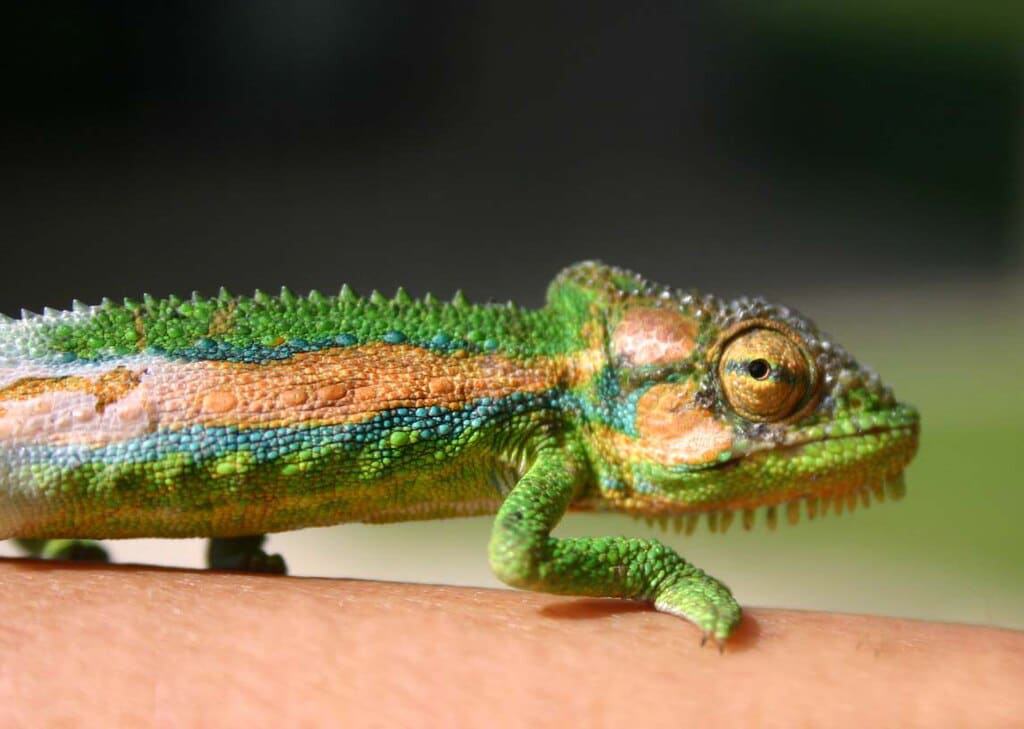
Few reptiles are more specialized for an arboreal lifestyle than chameleons, with their prehensile tails, zygodactyl feet (arranged in opposing pairs for gripping branches), and methodical climbing movements. Popular pet species include the veiled chameleon (Chamaeleo calyptratus), panther chameleon (Furcifer pardalis), and Jackson’s chameleon (Trioceros jacksonii), each offering distinctive appearances and care requirements. These specialized climbers move with deliberate precision through branches, using their remarkable tails as fifth limbs to secure themselves while reaching for new perches. Their independently rotating eyes allow them to scan for prey and predators without moving their heads, while their projectile tongues can extend to catch insects at remarkable distances. Chameleons require specialized care, including significant humidity, UVB lighting, and well-ventilated mesh enclosures that provide adequate airflow. While not suitable for handling or beginner keepers, their extraordinary adaptations, color-changing abilities, and unique behaviors make them fascinating subjects for dedicated reptile enthusiasts willing to meet their specific environmental needs.
2. Leopard Gecko (Eublepharis macularius)

Though traditionally categorized as terrestrial lizards, leopard geckos frequently display climbing behaviors when provided with appropriate opportunities in captivity. These popular desert-dwelling reptiles from Afghanistan, Pakistan, and northwestern India lack the specialized toe pads found in many arboreal gecko species, instead possessing clawed feet better suited for terrestrial locomotion. However, many leopard gecko keepers observe their pets scaling low rock formations, decorations, and gentle inclines, particularly when hunting or exploring. Juveniles especially, may exhibit more climbing tendencies than adults. While not requiring tall enclosures like true arboreal species, leopard geckos benefit from environmental enrichment that includes safe, sturdy climbing options under 12 inches in height. Their docile temperament, manageable size (8-10 inches), and straightforward care requirements make them excellent beginner reptiles. Including low climbing features in leopard gecko habitats provides physical exercise, mental stimulation, and allows these adaptable reptiles to express natural exploratory behaviors that enhance their wellbeing in captivity.
1. Gold Dust Day Gecko (Phelsuma laticauda)

Among the smallest pet day geckos, the gold dust day gecko packs extraordinary color and personality into a diminutive 4-5-inch package. Native to Madagascar but established in Hawaii, these diurnal climbers display vibrant green bodies adorned with distinctive red markings and scattered gold “dust” flecking on their upper bodies, coloration reminiscent of fine jewelry. Their specialized toe pads allow for effortless navigation of vertical surfaces,s including glass, making them true masters of three-dimensional movement. Unlike many nocturnal geckos, gold dusts are active during daylight hours, providing constant entertainment as they patrol their territories, hunt insects, and consume fruit nectar. Their small size means they require less space than larger day gecko species, making them suitable for beautifully planted 12x12x18-inch vertical terrariums. While too delicate for handling—their skin tears easily when grabbed—these geckos quickly become bold in captivity, often approaching the glass when their keepers are present and feeding from handheld cups with minimal shyness.
Conclusion: Creating Vertical Paradise for Your Climbing Companion
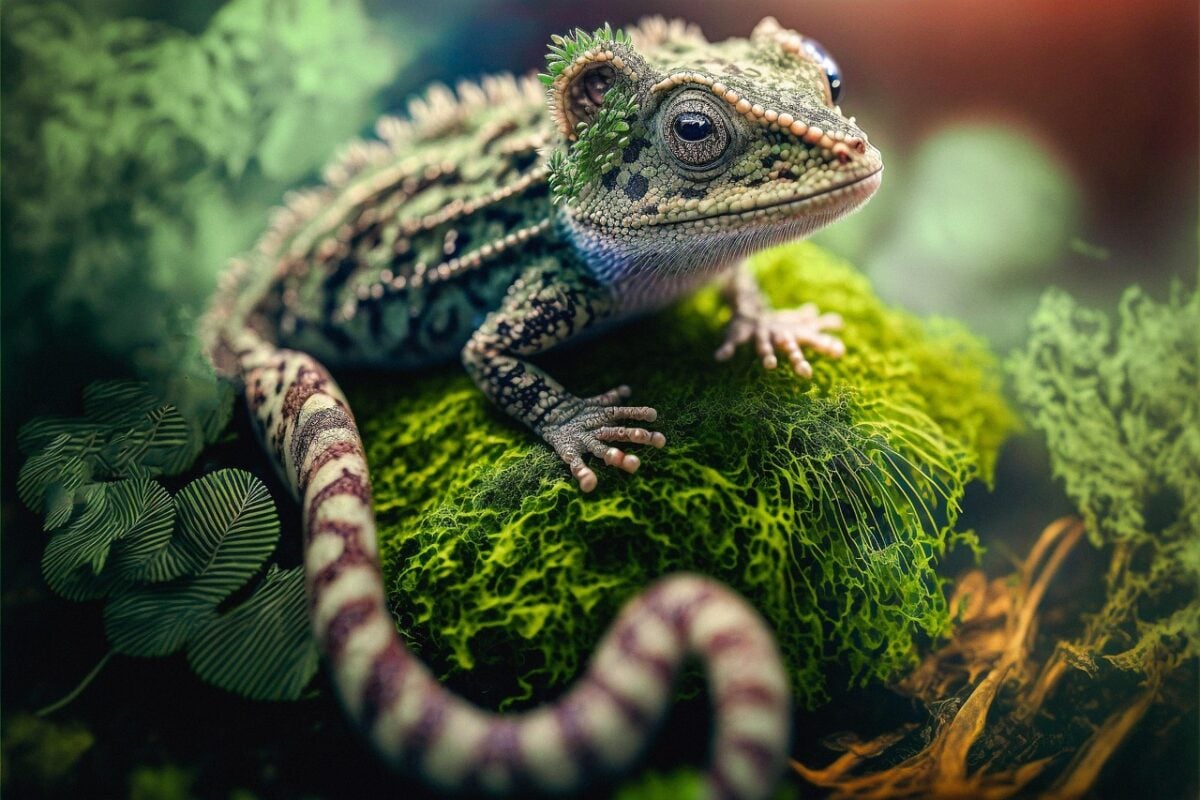
Selecting a climbing lizard as a pet opens up exciting possibilities for creating dynamic, naturalistic habitats that showcase these animals’ remarkable adaptive abilities. Each species brings unique care requirements, temperaments, and climbing styles that can transform reptile keeping from a simple hobby into a fascinating study of specialized evolutionary adaptations. When designing enclosures for these vertical explorers, prioritize height over floor space, incorporate various climbing surfaces with different textures and diameters, and arrange multiple basking spots at different elevations to encourage natural thermoregulation behaviors. Remember that climbing isn’t just entertainment—it provides essential exercise, mental stimulation, and allows these animals to express instinctual behaviors that contribute to their physical and psychological wellbeing. Whether you choose a beginner-friendly crested gecko or a more advanced species like a chameleon, the reward is watching these remarkable animals navigate their three-dimensional world with grace and precision that ground-dwelling species simply cannot match.
- The Hottest Temperature Ever Recorded in the US Desert - August 9, 2025
- 14 Myths About Horses (Busted by Experts) - August 9, 2025
- Why Orcas Are Outwitting Great White Sharks Near the California Coast - August 9, 2025

